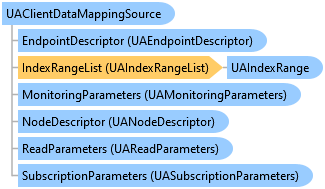

QuickOPC User's Guide and Reference
UAClientDataMappingSource Class


'Declaration<ComVisibleAttribute(False)> <CLSCompliantAttribute(True)> <TypeConverterAttribute(System.ComponentModel.ExpandableObjectConverter)> Public NotInheritable Class UAClientDataMappingSource Inherits UAMappingSource
'UsageDim instance As UAClientDataMappingSource
[ComVisible(false)] [CLSCompliant(true)] [TypeConverter(System.ComponentModel.ExpandableObjectConverter)] public sealed class UAClientDataMappingSource : UAMappingSource
[ComVisible(false)] [CLSCompliant(true)] [TypeConverter(System.ComponentModel.ExpandableObjectConverter)] public ref class UAClientDataMappingSource sealed : public UAMappingSource
The mapping source is a data provider and/or consumer external to your application code.
For OPC Data Access, there are two types of mapping sources that you can use:
For OPC Unified Architecture, following type of mapping source exists:
One mapping source can be (and often is) shared by multiple mappings. This happens e.g. when you map multiple members to the same source, using different Mapping Kinds (for example, you may map separate members to the value, timestamp, and quality information of the OPC item).
When you use the attributes to define the live mappings, mapping source objects are created and maintained together with their Mappings, so normally you do not deal with them directly.
System.Object
OpcLabs.BaseLib.LiveMapping.AbstractMappingSource
OpcLabs.EasyOpc.UA.LiveMapping.UAMappingSource
OpcLabs.EasyOpc.UA.LiveMapping.UAClientDataMappingSource